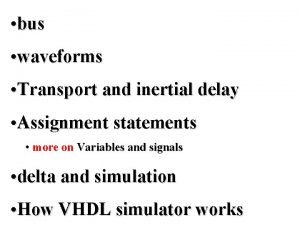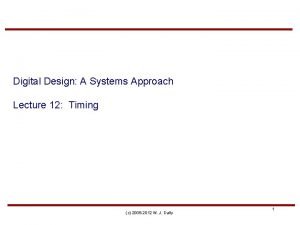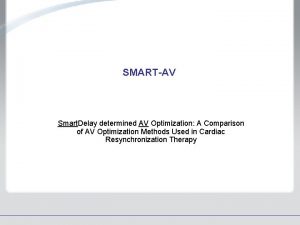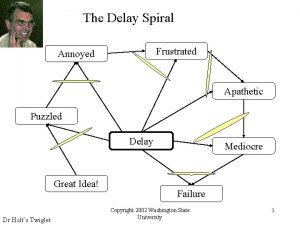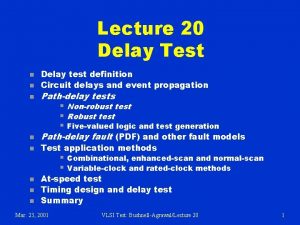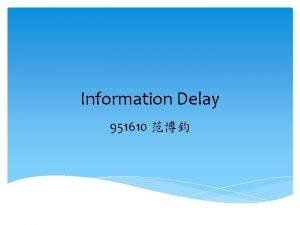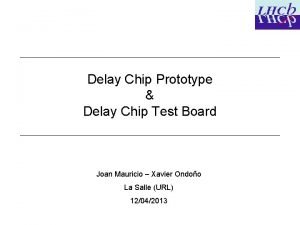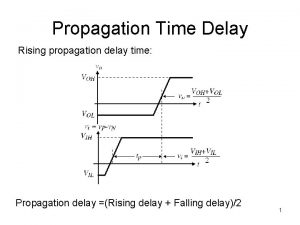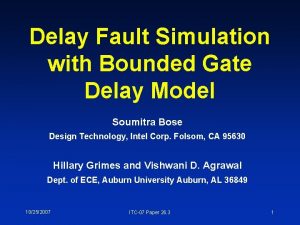SMARTAV Smart Delay determined AV Optimization A Comparison











- Slides: 11

SMART-AV Smart. Delay determined AV Optimization: A Comparison of AV Optimization Methods Used in Cardiac Resynchronization Therapy

DISCLAIMER Boston Scientific Education and Presentation Resources • Boston Scientific develops, manufactures and markets a broad array of products and services that enable lessinvasive care for some of the most threatening cardiac conditions. Its prescription devices for use by healthcare professionals are regulated by government agencies in each of the countries in which it does business, such as the Food and Drug Administration in the United States (U. S. ) or the Ministry of Health in Japan. These regulations often restrict the use of the information that can be disclosed to the public. If the format of the material presented is altered, the appropriate indications, contraindications, precautions, warnings and adverse events should be included. • This Presentation has been developed as a service of Boston Scientific. Like any other service, in spite of our best efforts the information in this Presentation may become out of date over time. Nothing on this Presentation should be construed as the giving of advice or the making of a recommendation and it should not be relied on as the basis for any decision or action. The materials on this Web Site are intended for educational purposes only. Boston Scientific accepts no liability for the accuracy or completeness or use of, nor any liability to update, the information contained on this Presentation. These materials are provided "AS IS" WITHOUT WARRANTY OF ANY KIND, EITHER EXPRESSED OR IMPLIED, INCLUDING, BUT NOT LIMITED TO, THE IMPLIED WARRANTIES OF MERCHANTABILITY, FITNESS FOR A PARTICULAR PURPOSE, OR NON-INFRINGEMENT. Some jurisdictions do not allow the exclusion of implied warranties, so the above exclusion may not apply to you. Copyright and Intellectual Property • Boston Scientific hereby authorizes you to copy materials published by it on the Cardiac Rhythm Resources Web Site for non commercial use only, provided any copy of these materials which you make shall retain all copyright and other proprietary notices and any disclaimer contained thereon and on this Web Site. • Nothing contained herein shall be construed as conferring by implication or otherwise any license or right under any patent or trademark of Boston Scientific or any third party. Except as expressly provided above, nothing contained herein shall be construed as conferring any license or right under any Boston Scientific copyright. Illustrations with the mark ©medmovie. com, are Copyright medmovie. com with all rights reserved.

SMART-AV Smart. Delay determined AV Optimization: A Comparison of AV Optimization Methods Used in Cardiac Resynchronization Therapy Status: Completed in 2010 • SMART-AV is the first large scale trial to compare methods of optimizing AV delay, evaluate if more frequent reoptimization can improve clinical outcomes, and assess whether acute benefits translate into chronic benefits

Design Baseline Evaluation To document inclusion / exclusion criteria and establish baseline heart status* Randomization (1: 1: 1 Smart. Delay: Echo: Fixed) 1 – 14 days post implant AV Delay Optimized Quarterly Using Smart. Delay Clinic Follow-up Visits 3 month and 6 months post implant AV Delay Optimized Using Echo (Iterative Method) AV Delay Fixed at 120 ms with 0 Offset

Patient Population • Eligible study participants included both male and female patients over 18 years of age whose disease state at the time of enrollment met indications for CRT-D therapy • 1060 patients were enrolled at 100 sites across the United States and Europe

Clinical Relevance • To assess the chronic effects of three methods for determining AV delay timing during CRT: EGM optimization, Echo optimization and fixed • Primary Endpoint: LVESV – Secondary endpoints include: 6 -minute walk, NYHA class and QOL • SMART-AV is the first large scale trial to compare methods of optimizing AV delay, evaluate if more frequent re-optimization can improve clinical outcomes, and assess whether acute benefits translate into chronic benefits

Results 1 • The change in LVESV for the Smart. Delay arm was no different than echocardiographic determined AV interval optimization as well as a Fixed AV delay of 120 ms. • Echo was not superior to a fixed AV delay.

References 1 Ellenbogen, K. , Gold, M. , et al. Primary Results from the SMARTAV Trial: A Randomized Trial Comparing Empiric, Echocardiographic Guided and Algorithmic AV Delay Programming in Cardiac Resynchronization Therapy (CRT). Circulation in press.

CRT-D Systems and Leads from Boston Scientific CRM Indications and Usage These Boston Scientific Cardiac Resynchronization Therapy Defibrillators (CRT-Ds) are indicated for patients with heart failure who receive stable optimal pharmacologic therapy (OPT) for heart failure and who meet any one of the following classifications: • Moderate to severe heart failure (NYHA Class III-IV) with EF ≤ 35% and QRS duration ≥ 120 ms • Left bundle branch block (LBBB) with QRS ≥ 130 ms, EF ≤ 30%, and mild (NYHA Class II) ischemic or nonischemic heart failure or asymptomatic (NYHA Class I) ischemic heart failure Contraindications There are no contraindications for this device. Warnings Read the product labeling thoroughly before implanting the pulse generator to avoid damage to the system. Such damage can result in patient injury or death. For single patient use only. Do not reuse, reprocess, or resterilize. Reuse, reprocessing, or resterilization may compromise the structural integrity of the device and/or lead to device failure which, in turn, may result in patient injury, illness, or death. Reuse, reprocessing, or resterilization may also create a risk of contamination of the device and/or cause patient infection or cross-infection, including, but not limited to, the transmission of infectious disease(s) from one patient to another. Contamination of the device may lead to injury, illness, or death of the patient. Program the pulse generator Tachy Mode to Off during implant, explant or postmortem procedures to avoid inadvertent high voltage shocks. Always have sterile external and internal defibrillator protection available during implant. If not terminated in a timely fashion, an induced tachyarrhythmia can result in the patient's death. Ensure that an external defibrillator and medical personnel skilled in CPR are present during post-implant device testing should the patient require external rescue. Advise patients to seek medical guidance before entering environments that could adversely affect the operation of the active implantable medical device, including areas protected by a warning notice that prevents entry by patients who have a pulse generator. Do not expose a patient to MRI device scanning. Strong magnetic fields may damage the device and cause injury to the patient. Do not subject a patient with an implanted pulse generator to diathermy since diathermy may cause fibrillation, burning of the myocardium, and irreversible damage to the pulse generator because of induced currents. Do not use atrial-tracking modes in patients with chronic refractory atrial tachyarrhythmias. Tracking of atrial arrhythmias could result in VT or VF. Do not use atrial-only modes in patients with heart failure because such modes do not provide CRT. LV lead dislodgment to a position near the atria can result in atrial oversensing and LV pacing inhibition. Physicians should use medical discretion when implanting this device in patients who present with slow VT. Programming therapy for slow monomorphic VT may preclude CRT delivery at faster rates if these rates are in the tachyarrhythmia zones. Do not kink leads. Kinking leads may cause additional stress on the leads, possibly resulting in lead fracture. Do not use defibrillation patch leads with the CRT-D system, or injury to the patient may occur. Do not use this pulse generator with another pulse generator. This combination could cause pulse generator interaction resulting in patient injury or lack of therapy delivery. For specific models, when using a subpectoral implantation, place the pulse generator with the serial number facing away from the ribs. Implanting the pulse generator subpectorally with the serial number facing the ribs may cause repetitive mechanical stress to a specific area of the titanium case, potentially leading to a component failure and device malfunction. Precautions For information on precautions, refer to the following sections of the product labeling: clinical considerations; sterilization, storage and handling; implant and device programming; follow-up testing; explant and disposal; environmental and medical therapy hazards; hospital and medical environments; home and occupational environments. Advise patients to avoid sources of electromagnetic interference (EMI) because EMI may cause the pulse generator to deliver inappropriate therapy or inhibit appropriate therapy. Potential Adverse Events Potential adverse events from implantation of the CRT-D system include, but are not limited to, the following: allergic/physical/physiologic reaction, death, erosion/migration, fibrillation or other arrhythmias, lead or accessory breakage (fracture/insulation/lead tip), hematoma/seroma, inappropriate or inability to provide therapy (shocks/pacing/sensing), infection, procedure related, and component failure. Patients may develop psychological intolerance to a pulse generator system and may experience fear of shocking, fear of device failure, or imagined shocking. In rare cases severe complications or device failures can occur. Refer to the product labeling for specific indications, contraindications, warnings/precautions and adverse events. Rx only. (Rev. N)

ICD Systems and Leads from Boston Scientific CRM ICD Indications and Usage ICDs are intended to provide ventricular antitachycardia pacing and ventricular defibrillation for automated treatment of life-threatening ventricular arrhythmias. ICDs with atrial therapies are also intended to provide atrial antitachycardia pacing and atrial defibrillation treatment in patients who have or are at risk of developing atrial tachyarrhythmias. Contraindications Use of ICD systems are contraindicated in: Patients whose ventricular tachyarrhythmias may have reversible cause, such as 1) digitalis intoxication, 2) electrolyte imbalance, 3) hypoxia, or 4) sepsis, or whose ventricular tachyarrhythmias have a transient cause, such as 1) acute myocardial infarction, 2) electrocution, or 3) drowning. Patients who have a unipolar pacemaker. Warnings Read the product labeling thoroughly before implanting the pulse generator to avoid damage to the ICD system. Such damage can result in patient injury or death. Program the pulse generator ventricular Tachy Mode to Off during implant, explant or post-mortem procedures to avoid inadvertent high voltage shocks. Always have sterile external and internal defibrillator protection available during implant. If not terminated in a timely fashion, an induced tachyarrhythmia can result in the patient’s death. Ensure that an external defibrillator and medical personnel skilled in cardiopulmonary resuscitation (CPR) are present during post-implant device testing should the patient require external rescue. Patients should seek medical guidance before entering environments that could adversely affect the operation of the active implantable medical device, including areas protected by a warning notice that prevents entry by patients who have a pulse generator. Do not expose a patient to MRI device scanning. Strong magnetic fields may damage the device and cause injury to the patient. Do not subject a patient with an implanted pulse generator to diathermy since diathermy may cause fibrillation, burning of the myocardium, and irreversible damage to the pulse generator because of induced currents. Do not use atrial tracking modes (or an AVT device) in patients with chronic refractory atrial tachyarrhythmias. Tracking of atrial arrhythmias could result in VT or VF. (Applies to dual-chamber devices only. ) Do not use this pulse generator with another pulse generator. This combination could cause pulse generator interaction resulting in patient injury or lack of therapy delivery. Do not kink leads. Kinking leads may cause additional stress on the leads, possibly resulting in lead fracture. For specific models, when using a subpectoral implantation, place the pulse generator with the serial number facing away from the ribs. Implanting the pulse generator subpectorally with the serial number facing the ribs may cause repetitive mechanical stress to a specific area of the titanium case, potentially leading to a component failure and device malfunction. Precautions For information on precautions, refer to the following sections of the product labeling: clinical considerations; sterilization, storage and handling; implantation and device programming; follow-up testing; explant and disposal; environmental and medical therapy hazards; home and occupational environments. Advise patients to avoid sources of electromagnetic interference (EMI) because EMI may cause the pulse generator to deliver inappropriate therapy or inhibit appropriate therapy. Potential Adverse Events Potential adverse events from implantation of the ICD system include, but are not limited to, the following: allergic/physical/physiologic reaction, death, erosion/migration, fibrillation or other arrhythmias, lead or accessory breakage (fracture/insulation/lead tip), hematoma/seroma, inappropriate or inability to provide therapy (shocks/pacing/sensing), infection, procedure related, psychologic intolerance to an ICD system - patients susceptible to frequent shocks despite antiarrhythmic medical management/imagined shocking, and component failure. In rare cases severe complications or device failures can occur. Refer to the product labeling for specific indications, contraindications, warnings/ precautions and adverse events. Rx only. (Rev. M)

Pacing Systems and Leads from Boston Scientific CRM Indications Pacemaker indications include: symptomatic paroxysmal or permanent second- or third-degree AV block; symptomatic bilateral bundle branch block; symptomatic paroxysmal or transient sinus node dysfunction with or without associated AV conduction disorders; bradycardia-tachycardia syndrome, to prevent symptomatic bradycardia or some forms of symptomatic tachyarrhythmias; neurovascular (vaso-vagal) syndromes or hypersensitive carotid sinus syndromes. Adaptive-rate pacing is indicated for patients who may benefit from increased pacing rates concurrent with increases in minute ventilation and/or level of physical activity. Pacemakers’ dual-chamber and atrial tracking modes are also indicated for patients who may benefit from maintenance of AV synchrony. Dual-chamber modes are specifically indicated for: conduction disorders that require restoration of AV synchrony, including varying degrees of AV block; VVI intolerance (eg, pacemaker syndrome) in the presence of persistent sinus rhythm. Contraindications Pacemakers are contraindicated for the following patients under the circumstances listed: patients with unipolar pacing leads or in MV mode with an implanted ICD because it may cause unwanted delivery or inhibition of ICD therapy; use of the MV sensor in patients with onlyunipolar leads, because a bipolar lead is required in either the atrium or the ventricle for MV detection (INSIGNIA® Plus, ALTRUA® 20/40); MV mode in patients with both unipolar atrial and ventricular leads (INSIGNIA® Ultra, ALTRUA® 60); single-chamber atrial pacing in patients with impaired AV nodal conduction; atrial tracking modes for patients with chronic refractory atrial tachyarrhythmias, which might trigger ventricular pacing; dual-chamber and single-chamber atrial pacing in patients with chronic refractory atrial tachyarrhythmias; asynchronous pacing in the presence (or likelihood) of competition between paced and intrinsic rhythms. Warnings Read the product labeling thoroughly before implanting the pulse generator to avoid damage to the system. Such damage can result in patient injury or death. Inappropriate sustained high-rate pacing occurred in the PULSAR™ MAX clinical study in 5 out of 130 patients with MV ON, 4 to 14 days after implant. If sustained high-rate pacing could be of concern, consider programming a reduced Max Sensor Rate or MV to Passive. These programming recommendations are intended to assure that MV calibration is evaluated and, if necessary, recalibrated (4 ON) when the patient and pacing system have stabilized post implant. Continued monitoring of the MV sensor performance should be performed at all follow-up visits until implant stabilization has occurred. Precautions For information on precautions, refer to the following sections of the product labeling: MV sensor calibration at implant; clinical considerations; sterilization, storage and handling; lead evaluation and connection; implantation; programming and pacemaker operation; MV initialization; environmental and medical therapy hazards; elevated pressure; explanted pacemakers. Advise patients to avoid sources of electric or magnetic interference (EMI). If the pacemaker inhibits or reverts to asynchronous operation at the programmed pacing rate or at the magnet rate while in the presence of the EMI, moving away from the source or turning it off will usually allow the pulse generator to return to its normal mode of operation. Potential Adverse Events Potential adverse events from implantation of the pacing system include, but are not limited to, the following: allergic/physical/physiologic reaction, death, erosion/migration, lead or accessory breakage (fracture/insulation/lead tip), hematoma/seroma, inappropriate or inability to provide therapy (pacing/sensing), infection, procedure related, and component failure. In rare cases severe complications or device failures can occur. Refer to the product labeling for specific indications, contraindications, warnings/precautions and adverse events. Rx only. (Rev. N)
 Inertial delay and transport delay
Inertial delay and transport delay Normally open, timed-closed contact symbol
Normally open, timed-closed contact symbol Propagation delay
Propagation delay Smart delay
Smart delay Limit comparison test and direct comparison test
Limit comparison test and direct comparison test Smart shopping everfi
Smart shopping everfi One smart man he felt smart
One smart man he felt smart Street smarts vs book smarts
Street smarts vs book smarts It's not how smart you are it's how you are smart
It's not how smart you are it's how you are smart Smart two men are
Smart two men are What is the next letter? a z b y c x d
What is the next letter? a z b y c x d It is not how smart you are it's how you are smart
It is not how smart you are it's how you are smart
